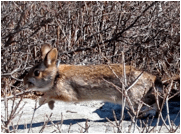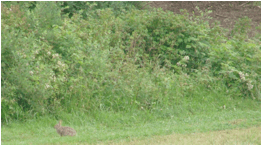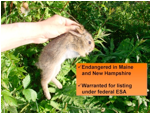Home → Fish & Wildlife → Wildlife → Endangered & Threatened Species → Endangered and Threatened Mammals
Endangered and Threatened Mammals

The New England cottontail (NEC; Sylvilagus transitionalis), or cooney, was listed as state endangered species in Maine in 2007 and is Maine's only endangered terrestrial mammal. New England cottontails are also listed as endangered in New Hampshire and the US Fish and Wildlife Service (USFWS) considers the species to be warranted but precluded from listing under the federal Endangered Species Act. In 2010, Maine's NEC population was estimated to be less than 200 rabbits. We determined the number of NEC in Maine by conducting intensive winter surveys to locate occupied patches of habitat and estimating the number of rabbits per acre based on the size of the habitat patch.

The region-wide decline of NEC has been attributed to habitat loss, in particular, the loss of old field and shrubby habitat. New England cottontails need dense shrubby habitat (the kind you would not want to try to walk through) to protect them from avian and terrestrial predators. Ideally, this dense cover should be interspersed with some grassy areas when the rabbits can find adequate food. Fortunately in Maine, the NEC does not have to compete with the non-native eastern cottontail rabbit (Sylvilagus floridanus) for limited habitat. The eastern cottontail is the rabbit that most people are familiar with in the Midwest and eastern US. Today, the eastern cottontail has expanded its range to include all of the other states in the original range of the NEC, and may pose threat to NEC in these states.
 Most people have a hard time believing that an animal that "breeds like a rabbit" could become endangered. The fact that a species, with a high reproductive rate like the NEC's, is endangered begs the question -- if New England's only native cottontail is endangered, what does it say about the status of other wildlife that live in brushy/early successional habitats or the health of the ecosystem in which they live?
Most people have a hard time believing that an animal that "breeds like a rabbit" could become endangered. The fact that a species, with a high reproductive rate like the NEC's, is endangered begs the question -- if New England's only native cottontail is endangered, what does it say about the status of other wildlife that live in brushy/early successional habitats or the health of the ecosystem in which they live?
Today, NECs only occupy about 20% of their former range and exist in three populations in Maine: 1) Cape Elizabeth / Scarborough, 2) Wells, and 3) Kittery/York/Elliot. These populations are not only separated by distance but by a landscape fragmented with roads and unsuitable habitat. Landscape fragmentation and the physical distance between NEC populations prevent NEC from moving between populations. Consequently, Maine's NEC populations are losing their genetic diversity and have a high risk of becoming extirpated (locally extinct), unless management actions are taken.

Much of the recovery work on NEC is accomplished by governmental and non-governmental partners working with IFW through Maine's NEC Working Group. In particular, the National Fish and Wildlife Foundation (NFWF), through its Keystone Initiative program, has provided essential support for NEC conservation in Maine. As a result of this program, over 600 acres have been brought under management for NEC. Although this is an excellent start, IFW and its partners have set a goal of creating over 3,600 acres of NEC habitat by 2030 in an effort to restore Maine's NEC population.
On a larger scale, Maine is a participant in the Regional New England Cottontail Initiative which is made up of representatives from state wildlife agencies in CT, MA, ME, NH, NY, and RI, along with representatives from the federal agencies that work with NEC. The members of the Initiative drafted a regional conservation strategy for NEC. Participating agencies have set a region-wide goal of restoring more than 42,000 acres of NEC habitat by 2030. This amount of additional habitat should support a NEC population of 22,000 rabbits.